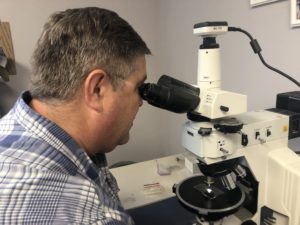
Petrography can tell you a lot about your concrete, aggregate, or masonry.
When could you benefit from petrography? What could you learn from it? At Beton, we use petrography to examine concrete, aggregates, cement, and masonry mortar. Various kinds of microscopes give us a detailed view of these materials. Depending on the project, we may use it alone or as part of a more elaborate test program.
Petrographic methods
- ASTM C856, Standard Practice for Petrographic Examination of Hardened Concrete, helps us identify potential causes of failure such as alkali silica reaction (ASR), sulfate attack, and acid attack. It also helps us assess the overall quality of the concrete.
- ASTM C457, Standard Test Method for Microscopical Determination of Parameters of the Air-Void System in Hardened Concrete, indicates the concrete’s potential durability in freezing and thawing. If your concrete surface has scaled, you need to know whether the finishing or the concrete itself is the problem.
- ASTM C295, Standard Guide for Petrographic Examination of Aggregates for Concrete, is a tool for evaluating aggregates. If it’s likely to be susceptible to alkali-silica reactivity, we may want to conduct additional tests. We can also recommend mitigation methods so you can use the aggregate with confidence.
- ASTM C1324, Standard Test Method for Examination and Analysis of Hardened Masonry Mortar, helps us evaluate historic mortar for a rehabilitation project. It’s also useful in troubleshooting masonry problems.
Questions? Email Mark Lukkarila, principle petrographer and materials scientist
